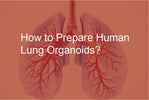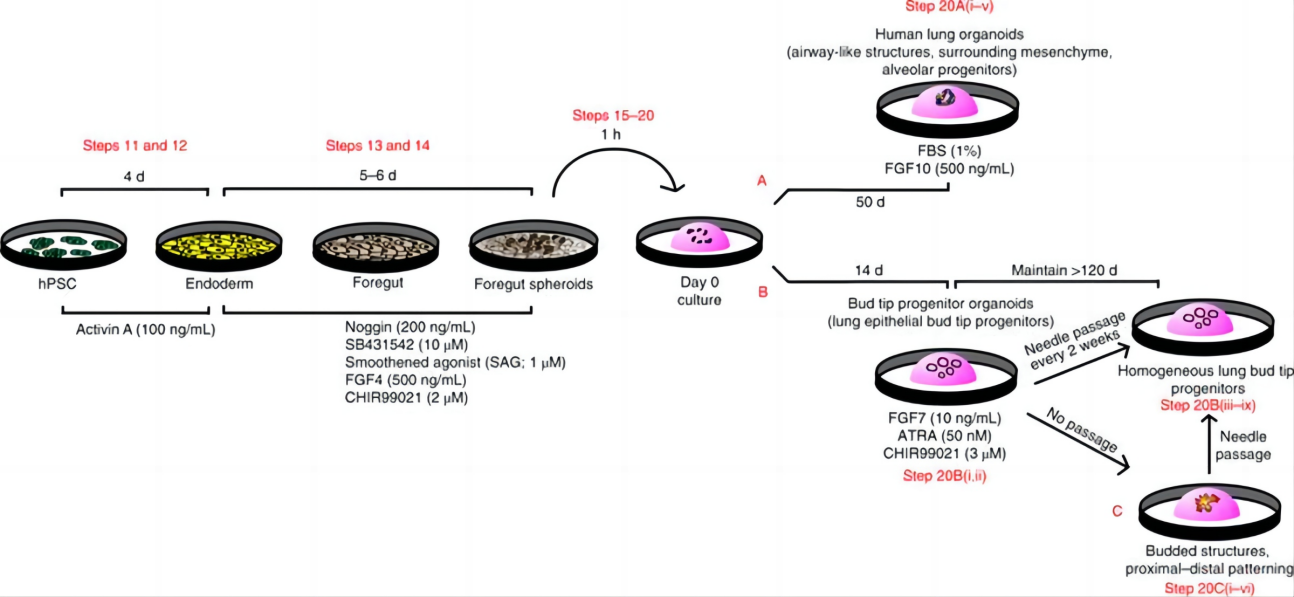How to Prepare Human Lung Organoids

In the late stages of lesion, the novel coronavirus can extensively infect lung tissues, potentially causing severe damage to lung function. Over the past three years, human stem cell-derived organoids have become advantageous tools for COVID-19 research.
Human lung organoids (hLOs) possess structures similar to bronchi and alveoli, resembling the structure and function of human lung tissues, making the cultivation process complex. Researchers induce pluripotent stem cells to form endoderm using small molecule compounds and cytokines, then allow the endoderm to form three-dimensional tissues, obtaining tissues similar to early embryonic lungs, and further developing them into lung tissues.
There are various protocols for culturing human lung organoids. Next, we will summarize the general process of forming human lung organoids and bud tip progenitor organoids from human pluripotent stem cells (hPSCs) based on articles by Han and Alyssa J Miller et al. [1][2].

Figure 1 Process of hPSC-Derived Human Lung Organoids and Bud Tip Progenitor Organoids by Alyssa J Miller et al. [2]
Directed Differentiation of hPSC into Endoderm
hPSCs were dissociated using Accutase and seeded onto low-adhesion 6-well plates, suspended in serum-free differentiation medium containing 10μM Y-27632 , 0.5 ng/mL human BMP4 , 2.5 ng/mL human bFGF , and 100 ng/mL human Activin A , and cultured for 3-4 days.
Induction of Foregut Spheroids Formation
To induce foregut spheroids formation, the medium was replaced with foregut differentiation medium: DMEM/F12 medium supplemented with 1× N-2 , 1× B27, 10 mM HEPES , 1× L-glutamine , 10 µM SB431542 , 200 ng/mL human Noggin , 1 µM SAG, 500 ng/mL human FGF4, and 2 µM CHIR99021 , and cultured for 5 days.
Then,the floating spheroids were collected without disrupting the monolayer of cells, transferred to new centrifuge tubes, and seeded onto plates containing Matrigel, followed by incubation at 37°C.

Figure 2 Bright-field images of foregut spheroids [2].
Induction of human lung organoids and bud tip progenitor organoids
3.1 Induction of human lung organoids
Human lung organoids were induced by adding human lung organoid induction medium to the foregut spheroids: DMEM/F12 medium supplemented with 1× N-2 , 1× B27, 1% FBS, 10 mM HEPES, 1× L-glutamine, and 500 ng/mL human FGF10 , with medium change every two weeks.
Approximately 50 days were required to generate human lung organoids, exhibiting a network of dispersed epithelial cells with airway-like epithelial cells surrounded by mesenchymal cells and expressing markers of alveolar epithelial cells.

Figure 3 Bright-field image of expected growth pattern of human lung organoids [2]
3.2 Induction of Bud Tip Progenitor Organoids
Add human lung organoid induction medium to the anterior intestinal sacs: Add 1× N-2 , 1× B27 , 10 mM HEPES , 1× L-glutamine, 10 ng/mL human FGF7, 0.5% BSA , 50 µg/mL ascorbic acid , 3 µM CHIR99021 , 50 nM ATRA , and 0.4 µM monothio-glycerol to DMEM/F12 medium, then culture the mixture. Change the medium every 2-3 days. Bud tip progenitor organoids will be generated.
After 22 days of culture, bud tip progenitor organoids contain a highly enriched and proliferating population of cells expressing transcription factors similar to human fetal bud tip progenitor cells, including SOX2+, SOX9+, ID2+, and NKX2.1+.

Figure 4 Bright field image of bud tip progenitor organoid growth pattern [2]
Related products
|
Product Type |
Product Name |
Catalog Number |
Specifications |
| Organoid Culture | 3DCultr Lung Cancer Organoid Growth Medium(Human) | C231110 | 50/100/500 mL |
|
Cell Digestion Solution |
Accutase |
C230116 |
100 mL |
|
Recombinant Protein |
Recombinant Human BMP-4 Protein |
C230310 |
10 μg/100 μg/500 μg |
|
Recombinant Protein |
Recombinant Human bFGF/FGF-2 Protein |
C230295 |
10 μg/100 μg/500 μg |
|
Recombinant Protein |
Recombinant Human/Mouse/Rat Activin A Protein |
C230520 |
10 μg/100 μg/500 μg |
|
Recombinant Protein |
Recombinant Human Noggin Protein,His Tag |
C230462 |
5 μg/100 μg/500 μg |
|
Recombinant Protein |
Recombinant Human FGF-4 Protein |
C230346 |
5 μg/100 μg/500 μg |
|
Recombinant Protein |
Recombinant Human FGF-10 Protein, His Tag |
C230418 |
5 μg/100 μg/500 μg |
|
Recombinant Protein |
Recombinant Human KGF/FGF-7 Protein |
C230417 |
10 μg/100 μg/500 μg |
